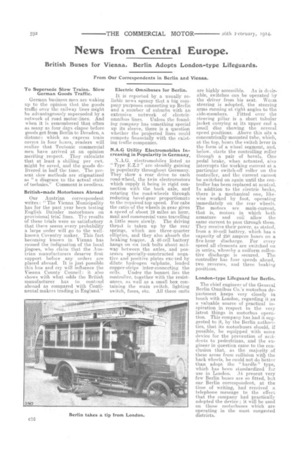News from Central Europe.
Page 20

If you've noticed an error in this article please click here to report it so we can fix it.
British Buses for Vienna. Berlin Adopts London-type Lifeguards.
From Our Correspondents in Berlin and Vienna.
To Supersede Slow Trains. Slow German Goods Traffic.
German business men are waking up to the opinion that. the goods traffic over the railway lines 'night be advantageously superseded by a network of road motor-lines. And when it is remembered that often as many as four days elapse before goods get from Berlin to Dresden, a distanc3 which an express train covers in four hours, readers will realize that Teutonic commercial men have arrived at an opinion meriting respect. They calculate that at least a shilling per cwt. might be saved, and the goods delivered in half the time. The present slow methods are stigmatized as " a disgrace to the actual state of technics." Comment is needless.
British-made Motorbuses Abroad
Our Austrian correspondent writes : " The Vienna Municipality has for the past year been testing English Daimler motorbuses on provisional trial lines. The results of these trials were so satisfactory that there seems every probability a large order will go to the wellknown Coventry maker. This fact becoming known in Vienna has roused the indignation of the local jingoes, who claim that the Austrian ma.nufacturers deserve first support before any orders are placed abroad. It is just possible this hue and cry will influence the Vienna County Council : it also shows with what odds the British manufacturer has to contend abroad as compared with Continental makers trading in England." Electric Omnibuses for Berlin.
It is" reported by a usually reliable news agency that a big company purposes connecting up Berlin and a number of suburbs with an extensive network of electricomnibus lines. Unless the founding company has something special up its sleeve, there is a question whether the projected lines could compete financially with the existing traffic companies.
N.A.G Utility Electromobiles Increasing in Popularity in Germany.
N.A.G. electronnobiles listed as "Type F.Z.2 " arc steadily gaining in popularity throughout Germany. They show a. rear drive to each road-wheel, the twin electromotors which supply it being in rigid connection with the back axle, and rotating the road-wheels through reducing bevel-gear proportionate to the required top speed. For cabs the ratio of the wheels in gear gives a speed of about 19 miles an hour, mail and commercial vans travelling a little more slowly. The driving thrust is taken up by the mar springs, which are three-quarter elliptics, and they also absorb the braking tor.que. A 40-cell battery hangs on six lock bolts about midway between the axles, and possesses specially-constructed negathe and positive plates exc■ted by dilute hydrogen sulphate, leaded copper-strips inter-connecting the cells. Under the bonnet lies the controller, together with the resistances, as well as a small box containing the main switch, lighting switch, fuses, etc. All these units are highly accessible. As is desirable, switches can be operated by the driver from his seat. Worm steering is adopted, the steering arms running at right angles to the side-members. Fitted over the steering pillar is a short tubular jacket carrying at its upper end a small disc showing the several speed positions. Above this sits a concentrically-mounted tube, which, at the top, bears the switch lever in the form of a wheel segment, and, below, starts the controlling roller through a pair of bevels. One pedal brake, when actuated, also interrupts the working current at a particular switch-off roller on the controller, and the current cannot be switched on again until the controller has been replaced at neutral. In addition to the electric brake, there is a mechanical one, likewise worked by foot, operating immediately on the rear wheels. The motors are main-current, that is, motors in which both armature and coil allow the same current to pass through them. They receive their power, as stated, from a 40-cell battery, which has a capacity of 250 ampere hours on a five-hour discharge. For every speed all elements are switched on in series, whereby a uniform collective discharge is secured. The controller has four speeds ahead, two reverses, and three braking positions.
London-type Lifeguard for Berlin.
The chief engineer of the General Berlin Omnibus Co.'s motorbus department keeps very closely in touch with London, regarding it as a valuable source of practical inspiration in respect to the very latest things in motorbus operation. This company has had it suggested to it, by the Berlin authorities, that its motorbuses should, if possible, be equipped with sonic device for the prevention of accidents to pedestrians, and the engineer in question came to the conclusion that, as the majority of these arose from collision with the back wheels, he could not do better than adopt the "hurdle" type, which has been standardized for use in London. At present very few Berlin buses are so fitted, but our Berlin correspondent, at the time of writing, had received a telephone message to the effect that the company had practically adopted the device ; it will be used on those motorbuses which are operating in the most congested districts.


























